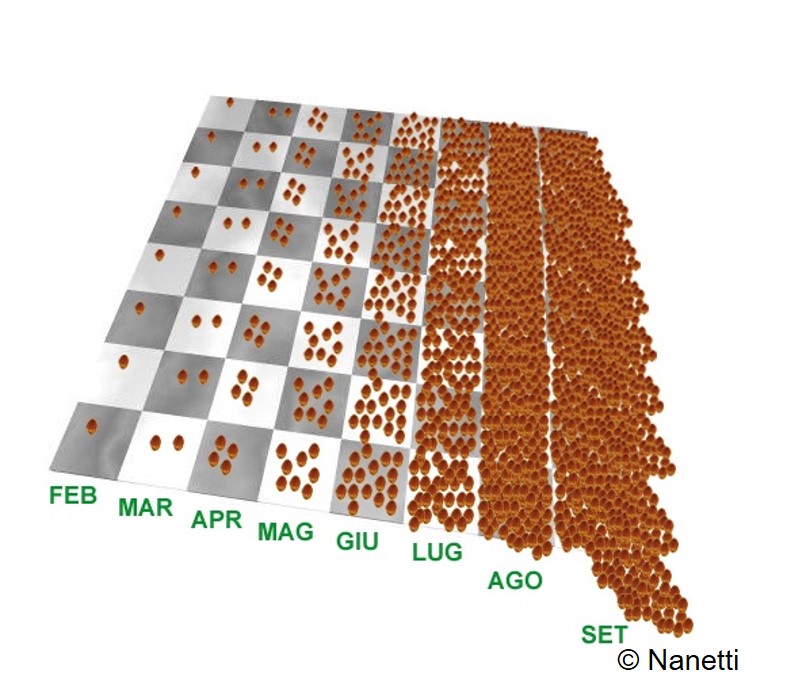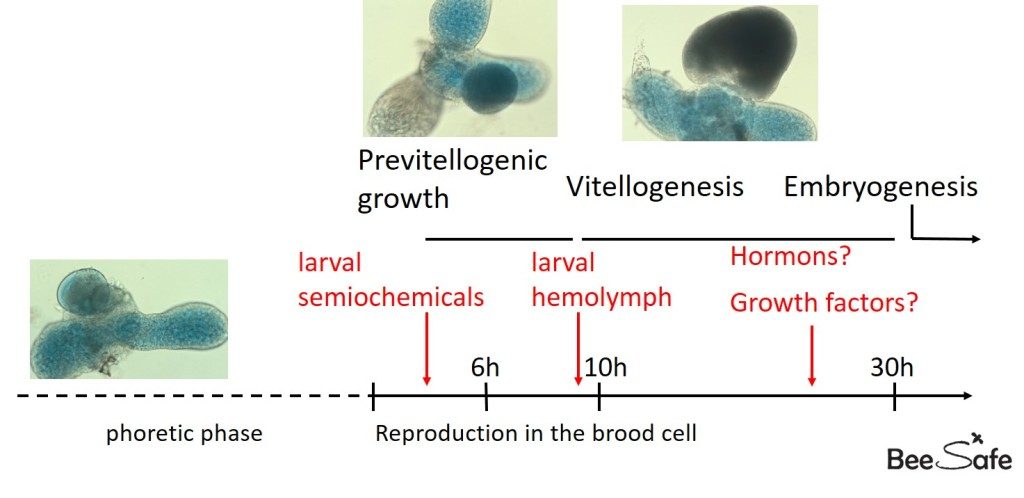In public perception, “ecology” is used mostly in the context of conservation and sustainability. The science with this name though, deals with the relationships between organisms, species, populations and their living (biotic) and dead (abiotic) environment. Every species is embedded in a net of relationsships with its surroundings: this is true for pollinators, their pests and diseases and even for humans. Our influence on this complex system of connections has been already addressed several times in this blog. Last week, I tried to give an overview about the pollinator-parasite interactions including the role of flowers in their transmission. This brought me to a very recently published review of Varroa ecology.
Varroa mites are exceptionally well adapted to their hosts. It is a big challenge and problem for beekeepers, and their main interest may be to have good treatment methods. But as always, the issue goes beyond the immediate interest of humans. Knowing more about a threat usually gives hints about solutions how to face them. In case of varroa, for example, the knowledge about its reproduction is crucial for the treatments. This parasite reproduces only in sealed brood cells of honey bees. In its original host, female mites lay eggs only in drone brood. Unfortunately for worldwide beekeeping, the parasite reproduces also in worker brood of European honeybees. This is the main reason for the damage done to Apis mellifera colonies and the rapid increase of infestation during the summer. In fact, the varroa population doubles every month. A colleague and friend had the great idea to visualize this with a chess board: if you start in the first row with one mite on each field (eight varroa), you will get 16 after a month, 32 after two and so on. After eight months, which could be a beekeeping season, out of these 8 mites became 1024. Considering a more realistic initial population of 50 varroa mites in early spring (after a good winter treatment) this will be 6,400 mites in September. Yes. That much. In a weak colony it could be as much as bees.

Varroa mites playing chess.
Communication between host and parasite
Knowing about reproduction of varroa mites, therefore, indicates when we have to treat if we want to have productive bee colonies during the season (winter treatment) and healthy winter bees (summer treatment). As the parasite reproduces only in sealed brood cells, the reproductive cycle must be closely aligned with the host reproduction. This is thus an example of such a relationship ecology deals with. There must be some “communication” between host and parasite. The latter has to “know” when it is time to enter the brood cells and speed up all the egg laying, offspring development and mating. Worker cells are sealed for twelve days, this is not much time. In this time, the mother mite has to produce as much viable offspring as possible. The first egg is laid already after 60-70 hours after sealing of the brood cell. It will become a male, every following egg is female. This means that mummy Varroa cannot just begin thinking of becoming pregnant when she is already in the brood cell. She must be prepared. My very modest contribution to the knowledge of this system was to develop bioassays to discover what starts the reproductive program of this major honeybee parasite. I spent much time at the microscope dissecting Varroa ovaries.

Varroa ovary with nutritive organ (lyraform organ) and spermatheca
All this to show that odours coming from the larvae (semiochemicals, kairomones) trigger the development of the first egg and therefore of the whole reproductive cycle of the parasite.

Beginning egg developement (oogenesis) is triggered by larval scents. Later, proteins from the bee pupae’s hemolymph make the egg grow.
So ecology is much more than clean cars, separating garbage or chasing butterflies in the rainforest. It may mean also sitting at the microscope, doing genetic analysis, using complicated lab equipment and inventing test systems.
A bee colony as environment
Within a honeybee colony, the environment is quite stable as the bees maintain temperature and humidity within a close range. V. destructor‘s physiology is adapted to these conditions and prefers a temperature around 32°C. Too cool temperatures limit the mite’s reproduction as well as too high humidity in the brood nest. All in all, the optimum range for varroa reproduction corresponds well to the conditions found in bee colonies.
Also the bees themselves are part of the varroa environment. Since my PhD thesis in which I studied the details explained above, there has been much effort to understand further this relationship. Bee scents play a role in finding the right brood cells and chemical cues help the bees to recognize infested ones. Other substances regulate the response of worker bees to the parasitation. Varroa mites can also hide from this response: they mimic (imitate) the substances from their host so they are not recognized. Furthermore, parasitism with varroa mites modulates the expression of genes involved in chemical communication of bees. As you can see, both bees and mites live in a quite chemical world. They communicate with scents as we do with words.

Summarizing Varroa ecology. Modified according to Nazzi and LeConte (2016).
As already discussed in last week’s post, Varroa mites also transmit viruses. By this, their influence from the inside of a bee hive becomes much bigger than it may initially seem. The ecological consequences strike not only honeybees, but other pollinators. And we depend on them for food. So here we are back with the human-centered view of ecology.



